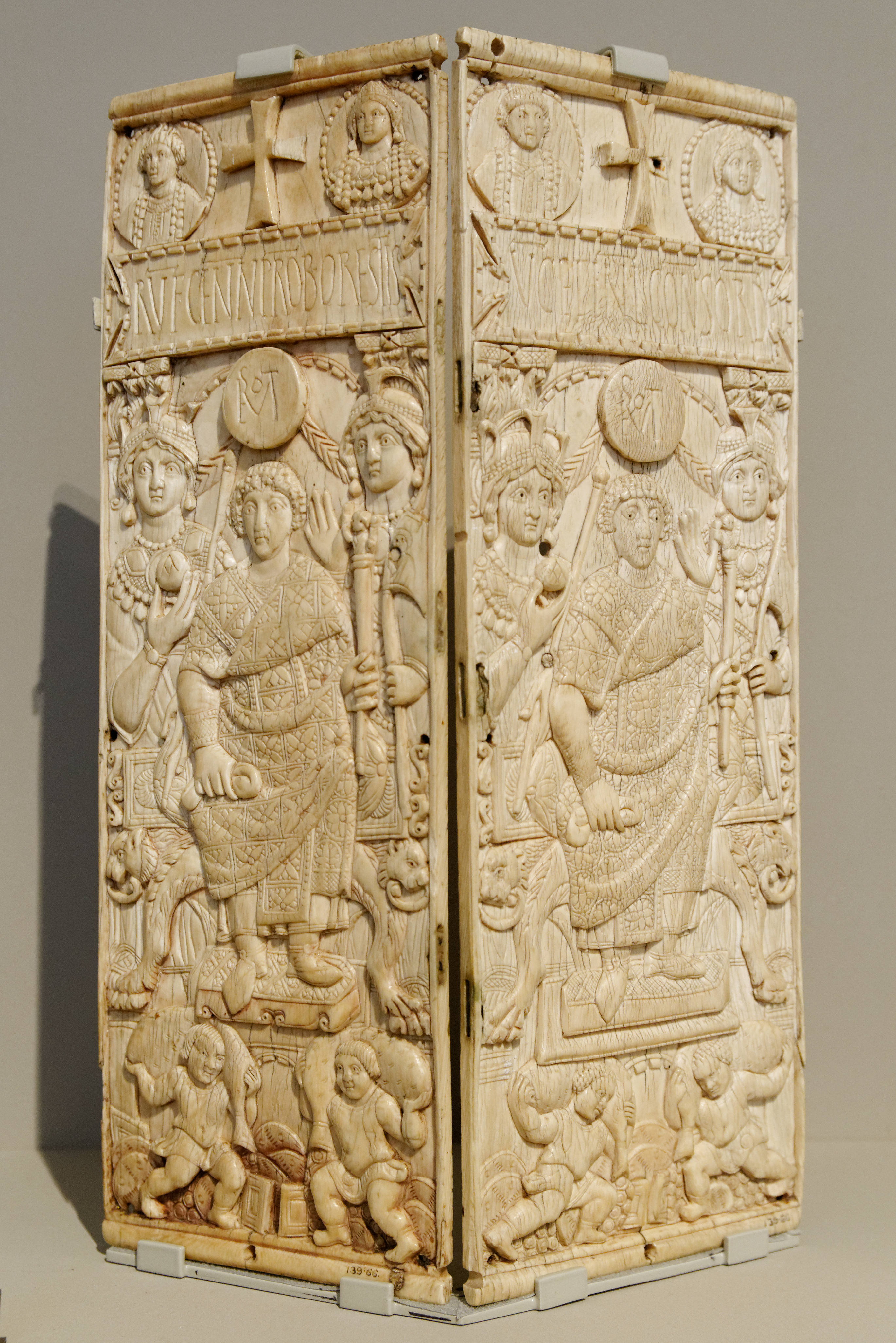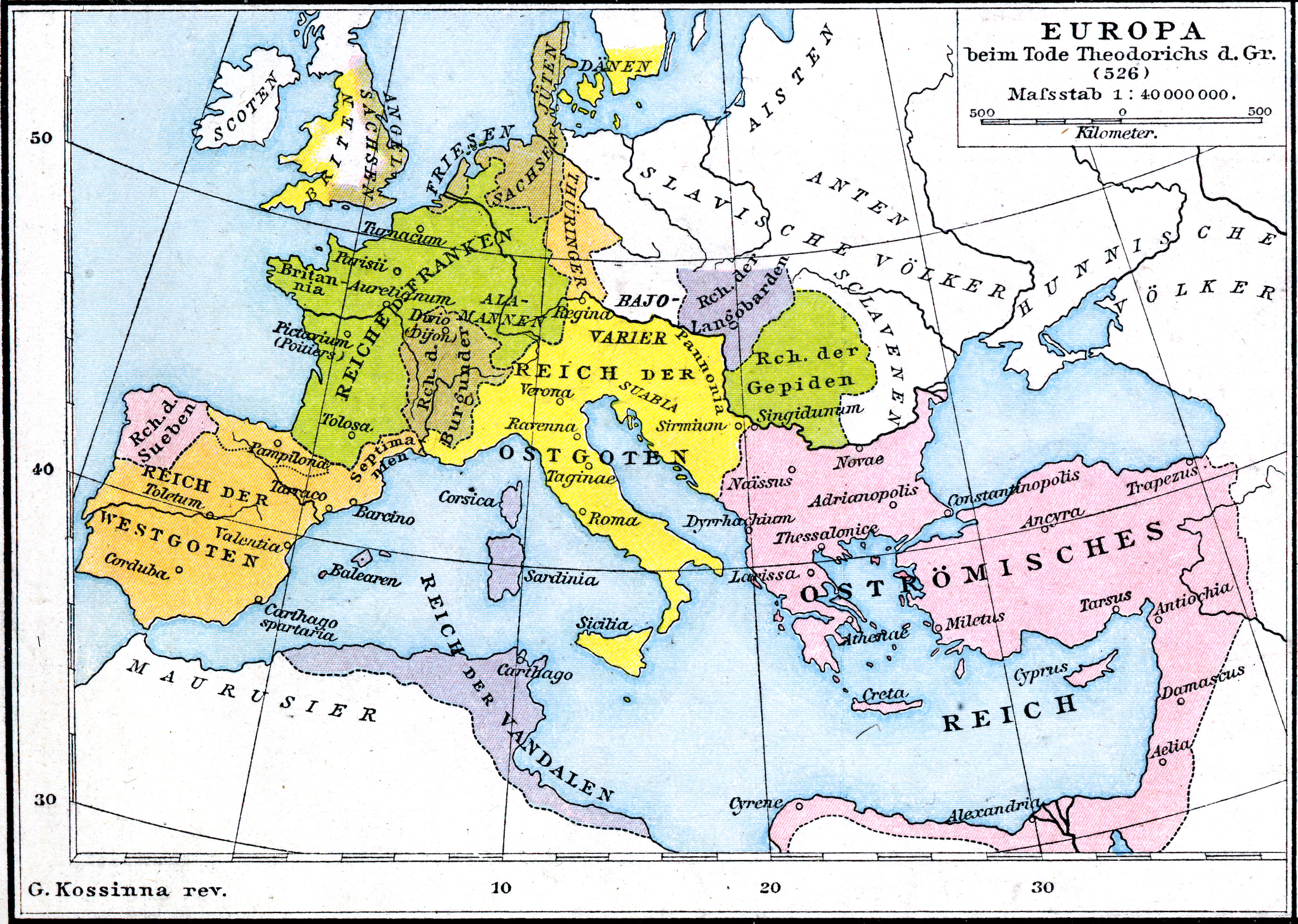|
Audofleda
Audofleda ( – ), was a Gothic queen of the Ostrogothic Kingdom by marriage to Theoderic the Great. She was the sister of Clovis I, King of the Franks. She married Theoderic the Great, King of the Ostrogoths (471–526), around 493 AD (exact date unknown). Theoderic sent an embassy to Clovis to request the marriage. This political move allied Theoderic with the Franks, and by marrying his daughters off to the kings of the Burgundians, the Vandals, and the Visigoths, he allied himself with every major 'Barbarian' kingdom in the West. Audofleda was a pagan prior to her marriage, and was baptised at the time of her wedding by an Arian bishop. Theoderic and Audofleda had one daughter, Amalasuntha, who ruled the Ostrogoths The Ostrogoths () were a Roman-era Germanic peoples, Germanic people. In the 5th century, they followed the Visigoths in creating one of the two great Goths, Gothic kingdoms within the Western Roman Empire, drawing upon the large Gothic populatio ... from 526 ... [...More Info...] [...Related Items...] OR: [Wikipedia] [Google] [Baidu] |
Amalasuntha
Amalasuintha (495 – 30 April 535) was a ruler of the Ostrogothic Kingdom from 526 to 535. Initially serving as regent for her son Athalaric, she became queen regnant after his premature death. Highly educated, Amalasuintha was praised by both Cassiodorus and Procopius for her wisdom and her ability to speak three languages (Greek, Gothic, and Latin). Her status as an independent female monarch, and obvious affinity for Roman culture, caused discontent among the Gothic nobles in her court, and she was deposed and killed after six months of sole rule. Eastern Roman Emperor Justinian I used her death as a ''casus belli'' to invade Italy, setting off the Gothic War. Family Amalasuintha was likely born in Ravenna in 495, the only child of Theodoric and his wife Audofleda, the sister of Clovis, King of the Franks. The union of Amalasuintha's parents were of a political purpose, as many royal marriages were at the time. Theodoric married Audofleda about the year 493, after he had ... [...More Info...] [...Related Items...] OR: [Wikipedia] [Google] [Baidu] |
Childeric I
Childeric I (died 481 AD) was a Frankish leader in the northern part of imperial Roman Gaul and a member of the Merovingian dynasty, described as a king (Latin ''rex''), both on his Roman-style seal ring, which was buried with him, and in fragmentary later records of his life. He was father of Clovis I, who acquired effective control over all or most Frankish kingdoms, and a significant part of Roman Gaul. Biography Most of early Merovingian history is based on the account of the 6th-century Gregory of Tours. The date of Childeric's accession is not given in the text, but it was after emperor Avitus' death in December 456II. 11. The only certain date is the Battle of Vouillé in 507; most of Gregory's other statements are contradictory. Childeric's father is recorded by several sources to have been Merovech, after whom the dynasty is named. Gregory (II.9) says that Merovech was reputed by some to be a descendant of Chlodio, an earlier Frankish king who had conquered Gaulish ... [...More Info...] [...Related Items...] OR: [Wikipedia] [Google] [Baidu] |
Basina Of Thuringia
Basina or Basine ( 438 – 477) was remembered as a queen of Thuringia in the middle of the fifth century, by much later authors such as especially Gregory of Tours. However, because Gregory described her family's kingdom of Thuringia as being on the Gaulish or western side of the river Rhine, it is sometimes thought to be the Civitas Tungrorum, which is now Belgium. Biography Gregory of Tours reported that Childeric I was exiled from Roman Gaul for a period, and during that time he went to the kingdom of Thuringia. When he returned, Basina came with him, although she had allegedly been married to the king there, Bisinus. She herself took the initiative to ask for the hand of Childeric I, king of the Franks, and married him. For as she herself said, "I want to have the most powerful man in the world, even if I have to cross the ocean for him". Childeric and Basina were the parents of the Frankish king Clovis I, who is remembered as the first medieval king to rule Gaul.Hartma ... [...More Info...] [...Related Items...] OR: [Wikipedia] [Google] [Baidu] |
Theodoric The Great
Theodoric (or Theoderic) the Great (454 – 30 August 526), also called Theodoric the Amal, was king of the Ostrogoths (475–526), and ruler of the independent Ostrogothic Kingdom of Italy between 493 and 526, regent of the Visigoths (511–526), and a patrician (ancient Rome)#Late Roman and Byzantine period, patrician of the Byzantine Empire#Loss of the Western Roman Empire, Eastern Roman Empire. As ruler of the combined Gothic realms, Theodoric controlled an empire stretching from the Atlantic Ocean to the Adriatic Sea. Though Theodoric himself only used the title 'king' (''rex''), some scholars characterize him as a Roman Emperor#Later assertions to the title, Western Roman emperor in all but name, since he ruled a large part of the former Western Roman Empire described as a ''Res Publica'', had received the former Western imperial regalia from Constantinople in 497 which he used, was referred to by the imperial title ''princeps'' by the Italian aristocracy and exercised imper ... [...More Info...] [...Related Items...] OR: [Wikipedia] [Google] [Baidu] |
Clovis I
Clovis (; reconstructed Old Frankish, Frankish: ; – 27 November 511) was the first List of Frankish kings, king of the Franks to unite all of the Franks under one ruler, changing the form of leadership from a group of petty kings to rule by a single king, and ensuring that the kingship was passed down to his heirs. He is considered to have been the founder of the Merovingian dynasty, which ruled the Frankish kingdom for the next two centuries. Clovis is important in the historiography of France as "the first king of what would become France." Clovis succeeded his father, Childeric I, as a king of the Salian Franks in 481, and eventually came to rule an area extending from what is now the southern Netherlands to northern France, corresponding in Roman terms to Gallia Belgica (northern Gaul). At the Battle of Soissons (486), he established his military dominance of the Domain of Soissons, rump state of the fragmenting Western Roman Empire, which was then under the command of Sya ... [...More Info...] [...Related Items...] OR: [Wikipedia] [Google] [Baidu] |
List Of Italian Royal Consorts
Queen of Italy (''regina Italiae'' in Latin and ''regina d'Italia'' in Italian) is a title adopted by many spouses of the rulers of the Italian peninsula after the fall of the Roman Empire. The details of where and how the ruling kings ruled are in the article about them. The elective dignity of Roman Emperor was restricted to males only; therefore, there was never an Italian Queen regnant, though women such as Adelaide of Italy and Theophanu and Maria Theresa of Austria, who controlled the power of ruling, ruled as de facto Queens Regnant. Queen consorts of Italy, under Odoacer *''Unknown'' Ostrogothic Queen consorts of Italy Lombardic Queen consorts of Italy Queen consorts of Italy Carolingian dynasty, (774–887) After 887, Italy fell into instability, with many rulers claiming the Kingship simultaneously: Unruoching dynasty, (887–924) Widonid dynasty, (889–896) Carolingian Dynasty, (896–899) Bosonid dynasty, (900–905) Elder W ... [...More Info...] [...Related Items...] OR: [Wikipedia] [Google] [Baidu] |
Ostrogothic Kingdom
The Ostrogothic Kingdom, officially the Kingdom of Italy (), was a barbarian kingdom established by the Germanic Ostrogoths that controlled Italian peninsula, Italy and neighbouring areas between 493 and 553. Led by Theodoric the Great, the Ostrogoths killed Odoacer, a Germanic soldier and erstwhile leader of the . Odoacer had previously become the ''de facto'' Kingdom of Odoacer, ruler of Italy following his deposition of Romulus Augustulus, the final emperor of the Western Roman Empire, in 476. Under Theodoric, the Ostrogothic kingdom reached its zenith, stretching from Southern France in the west to Geography of Serbia, Western Serbia in the southeast. Most of the Roman society, social institutions of the Fall of the Western Roman Empire, late Western Roman Empire were preserved during his rule. Theodoric called himself "King of the Goths and Succession of the Roman Empire, Romans" (), demonstrating his desire to be a leader for both peoples. Under Justinian I, the Byzantine ... [...More Info...] [...Related Items...] OR: [Wikipedia] [Google] [Baidu] |
Merovingian Dynasty
The Merovingian dynasty () was the ruling family of the Franks from around the middle of the 5th century until Pepin the Short in 751. They first appear as "Kings of the Franks" in the Roman army of northern Gaul. By 509 they had united all the Franks and northern Gallo-Romans under their rule. They conquered most of Gaul, defeating the Visigoths (507) and the Burgundians (534), and also extended their rule into Raetia (537). In Germania, the Alemanni, Bavarii and Saxons accepted their lordship. The Merovingian realm was the largest and most powerful of the states of western Europe following the breakup of the empire of Theodoric the Great. The dynastic name, medieval Latin or ("sons of Merovech"), derives from an unattested Frankish language, Frankish form, akin to the attested Old English , with the final -''ing'' being a typical Germanic languages, Germanic patronymic suffix. The name derives from Salian Franks, Salian King Merovech, who is at the center of many legends. Unl ... [...More Info...] [...Related Items...] OR: [Wikipedia] [Google] [Baidu] |
5th-century Frankish People
The 5th century is the time period from AD 401 (represented by the Roman numerals CDI) through AD 500 (D) in accordance with the Julian calendar. The 5th century is noted for being a period of migration and political instability throughout Eurasia. It saw the collapse of the Western Roman Empire, which came to a formal end in 476 AD. This empire had been ruled by a succession of weak emperors, with the real political might being increasingly concentrated among military leaders. Internal instability allowed a Visigoth army to reach and ransack Rome in 410. Some recovery took place during the following decades, but the Western Empire received another serious blow when a second foreign group, the Vandals, occupied Carthage, capital of an extremely important province in Africa. Attempts to retake the province were interrupted by the invasion of the Huns under Attila. After Attila's defeat, both Eastern and Western empires joined forces for a final assault on Vandal North Africa, but t ... [...More Info...] [...Related Items...] OR: [Wikipedia] [Google] [Baidu] |
6th-century Ostrogothic People
The 6th century is the period from 501 through 600 in line with the Julian calendar. In the West, the century marks the end of Classical Antiquity and the beginning of the Middle Ages. The collapse of the Western Roman Empire late in the previous century left Europe fractured into many small Germanic kingdoms competing fiercely for land and wealth. From the upheaval the Franks rose to prominence and carved out a sizeable domain covering much of modern France and Germany. Meanwhile, the surviving Eastern Roman Empire began to expand under Emperor Justinian, who recaptured North Africa from the Vandals and attempted fully to recover Italy as well, in the hope of reinstating Roman control over the lands once ruled by the Western Roman Empire. Owing in part to the collapse of the Roman Empire along with its literature and civilization, the sixth century is generally considered to be the least known about in the Dark Ages. In its second golden age, the Sassanid Empire reached the ... [...More Info...] [...Related Items...] OR: [Wikipedia] [Google] [Baidu] |






